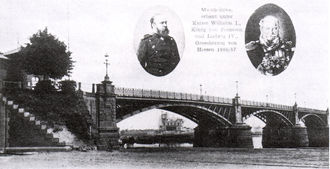Offenbach-Fechenheim Main Bridge
The Offenbach-Fechenheim Main Bridge connected Offenbach am Main with the Frankfurt-Fechenheim industrial area from 1887 to 1952 . Until 1819 there was only one connection between the Offenbach and Fechenheim banks of the Main, with boats called Schelch , which operated near the Offenbach town center at Isenburg Castle .
history
Ship bridge at Isenburg Castle from 1819
The first bridge between Offenbach and Fechenheim was a ship bridge inaugurated in June 1819 . It was on the Schloßstraße on the Offenbacher side and the Starkenburger Straße in Fechenheim. An important reason for building the bridge was to bypass customs in Frankfurt. The Grand Duchy of Hesse ( Offenbach am Main ) and Kurhessen ( Fechenheim ) were already part of the German Customs Union , which the Free City of Frankfurt only reluctantly joined in 1835. This was the first Main Bridge between the two Hessian states. The name of the northern access road is reminiscent of the bridge's “international” character to this day: From Fechenheim in the Electorate of Hesse , one reached the ship's bridge over Starkenburger Strasse , which led across to the Grand Ducal Hesse province of Starkenburg .
In spite of the tariffs saved on the thus bypassed Frankfurt state border, the use of the bridge cost money, as on numerous other Main bridges, tolls were levied on the ship bridge - and also on its successor into the 20th century .
Offenbach-Fechenheim Main Bridge from 1887
With Offenbach's growth as an industrial city and increasing shipping on the Main, the ship bridge was increasingly perceived as a traffic obstacle. Due to the strong growth of the city during the Wilhelminian era, Offenbach developed mainly to the west, where the Kaiserstraße , which runs from south to north, was created as the city's new boulevard and connection between Offenbach Central Station and Main . The Offenbach-Fechenheim Main Bridge was therefore not planned to replace the old one, but one kilometer downstream on the Kaiserstraße. After its completion in 1887, the ship bridge at Isenburg Castle was dismantled. In their place, like before 1819, a ferry operated, which continued to operate until 1965.
Offenbach-Fechenheim Main Bridge from 1934
At the beginning of the 1930s, the previous bridge construction was no longer able to cope with the increasing traffic load - in 1930 the maximum speed for vehicles on the narrow bridge had to be reduced to 15 kilometers per hour and in 1931 the gross vehicle weight had to be reduced to nine tons. In 1933/34 the bridge was therefore rebuilt. The old superstructure was replaced by a wider steel structure and the usable width was increased from six and a half to eleven meters. At the same time, the bridge was provided with electrical street lighting. In the spring of 1945, the bridge was blown up by Wehrmacht pioneers in order to make it more difficult for the American forces advancing from the south.
The provisional reconstruction took place on August 11, 1947 as one of the first Main bridges to be restored in the Frankfurt area. In 1952/53 the temporary solution was replaced by today's Carl-Ulrich-Brücke after a renovation .
literature
- Wolfram Gorr: Frankfurt bridges. Societäts-Verlag, Frankfurt am Main (Germany), ISBN 3-7973-0393-9 , 1982, pp. 27-36.
Web links
Individual evidence
- ↑ Offenbach - the small city on the Main. In: offenbach.de. Offenbacher Stadtinformation Gesellschaft, August 11, 2005, accessed on October 18, 2019 .
- ↑ Fabian El Cheikh: New Carl Ulrich Bridge without toll. In: op-online.de . November 16, 2012, accessed October 18, 2019 .
- ↑ a b Bridge building from Fechenheim to Offenbach for 300 years. In: fnp.de . September 3, 2016, accessed October 18, 2019 .
Coordinates: 50 ° 6 ′ 43 " N , 8 ° 45 ′ 26.9" E
